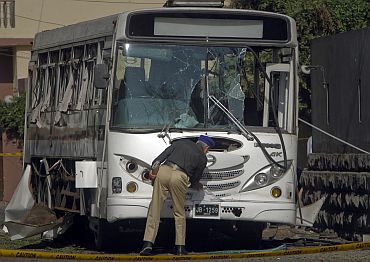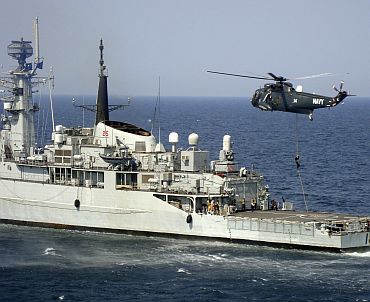Photographs: Athar Hussain/Reuters B Raman
Senior analyst B Raman explains why the Pakistani navy has been the favorrite target of jihadists.
The explosions targeted two buses of the Pakistan navy which were transporting naval personnel to their places of work. According to available indications, the improvised explosive devices, which struck the buses, had been planted along routes normally taken by the buses and activated through mobile telephones.
According to the Daily Times of Lahore, the Tehrik-e-Taliban Pakistan, as the Pakistani Taliban is known, has claimed the responsibility for the blasts, and threatened more attacks on security forces.
The claim was made in a telephone call to a foreign news agency by a person who identified himself as Ehsanullah Ehsan, a spokesman of the Taliban. He reportedly said: "Security forces will be targeted in the future as well, because they are killing their own people in Waziristan and elsewhere at the behest of the United States."
Please ...
Why extremists target Pakistani navy
Image: Officials survey the site where a suicide bomber killed at least six people and wounded 19 in an attack on a Pakistan naval college in Lahore in May, 2008.Photographs: Mohsin Raza/Reuters
This is the third time that the Pakistan navy has been targeted by jihadi terrorists since the raid into the Lal Masjid of Islamabad by the Pakistan army in July 2007, triggered off a wave of terrorist attacks on the Pakistani armed forces by suspected elements from the TTP.
They were both on motor-cycles. One of them rammed his motor-cycle against the security gate at the rear of the building breaking it open. The other drove through this opening into the parking area and blew himself up.
Their target was the naval institution and not any particular individual or individuals inside. They wanted to demonstrate their ability to penetrate the campus and cause damage.
Six persons were killed in the attack -- one of them a naval officer, three members of the security guards at the gate and the two suicide bombers.
Why extremists target Pakistani navy
Image: A navy personnel stands guard outside Pakistan's naval headquarters after a suicide bomb attack in Islamabad in December, 2009Photographs: Adrees Latif/Reuters
The second attempted attack was reported from Islamabad on December 2, 2009. An alert official of the Pakistani naval intelligence in plain clothes and a naval security guard in uniform deployed outside the building of the Pakistan navy headquarters in Islamabad prevented what could have been a major terrorist strike against the naval headquarters by an unidentified suicide bomber.
Spotting a suspicious-looking individual outside the NHQ, they stopped him and searched him. He turned out to be a suicide bomber wearing a concealed suicide vest.
However, they could not prevent him from activating the explosive device in the vest. One person was killed on the spot and another succumbed to his injuries later.
The Pakistan navy has had no role to play in the operations in the Lal Masjid, the Federally-Administered Tribal Areas and Swat.
However, the logistic supplies for the NATO forces are brought to the Karachi port, unloaded there under the protection of the Pakistani navy and then transported to Afghanistan by trucks.
Why extremists target Pakistani navy
Image: A Pakistani soldier abseils onto a ship during a military exercise codenamed Sea Spark in Araban Sea near Karachi in October, 2009.Photographs: Faisal Aziz/Reuters
While the Pakistani army and air force have no operational role to play in the US-led military operations in the Afghan territory against Al Qaeda and the Neo Taliban, the Pakistani navy is a member of the US-led international naval force which patrols the seas to the west of Pakistan to prevent any hostile activity which could hamper the operations in Afghan territory.
The Combined Task Force 150, established at the beginning of Operation Enduring Freedom in 2001, comprises naval forces from France, Germany, Italy, Pakistan, the United Kingdom and the United States.
The task force conducts maritime security operations in the Gulf of Aden, the Gulf of Oman, the Arabian Sea, the Red Sea, and the Indian Ocean.
The leadership of the Task Force is rotated amongst the participating navies. A Pakistani naval officer has been commanding it off and on when the turn of the Pakistan navy comes.





article